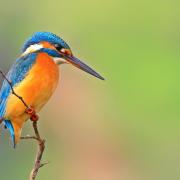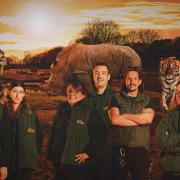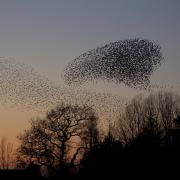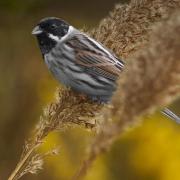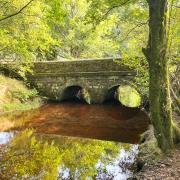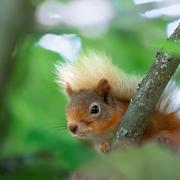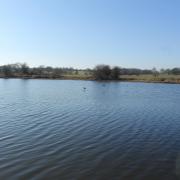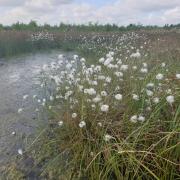From the wilds of Africa to the hills of Lancashire, Ribble Valley photographer Irene Amiet loves to capture nature at its best. Emma Mayoh reports.

‘It’s one of those moments you never forget,’ recalled photographer Irene Amiet. ‘Usually on night safaris there would be at least a few vans out there, searching for a glimpse of an animal. But that night, there was just us.
‘Suddenly we spotted a leopard and it felt like there was only us there. When this female looked me right in the eye. There was a connection. There was a moment of intimacy between the large predator and me.’
Swiss-born Irene has been clutching a camera since her 12th birthday. Holidays and trips out with her family were spent looking for ideal picture opportunities.
‘I felt like a photographer even then,’ she said. ‘The camera was a birthday present. I travelled a bit when I was a child and would take pictures of anything I could. I didn’t think about making a career out of it at first, although I dreamed I could. But I just loved taking pictures.’

At 21 she left her home country and joined a conservation project in Panama working as a research volunteer with Leatherback Turtles. But it was on a trip to Africa when she really hit her stride. She went there to participate in a big cat density research programme. When this finished she got a job in marketing at the Edeni Lodges in Limpopo. Part of her deal included the opportunity to go out on game drives whenever she wanted. This meant the chance to photograph up close some of the world’s rarest and most sought after animals.
‘Everything there is magical,’ said Irene. ‘I was in Kruger Park and there was really that sense of vulnerability of humans when away from civilisation. And that there is so much more to the world than us.
‘It really was a great time and I got to work on amazing projects.’
It was an experience that also opened Irene’s eyes to the immense conservation challenges that are faced in Africa. And during her trip she took photographs in a bid to raise awareness of that uphill struggle to keep endangered species protected.
‘Working in conservation I felt I was really able to play a part. I used my pictures to make people look,’ she said. ‘But the tricky bit is coming up with new ways of shooting the same thing.
‘We all love leopards and big cats but I wanted to be different. If you have a big cat in front of you, you get that chill down your spine. You know you are not top of the food chain anymore. It was six months before I first saw a leopard clearly to make it picture perfect. But getting it was a magical experience.’
After a year Irene moved to Texas. Nothing could have prepared her for the change in climate. The wilderness was replaced with a fairly uninteresting coastline and the wildlife was not as forthcoming.
‘I had to learn to look at lot harder, a lot more carefully,’ said Irene. ‘It wasn’t all there in front of me like it had been in Africa. But if you were willing to look, you could find it.
‘A real highlight for me was showing people a different side to fairly usual bird species. I captured a great egret doing a mating dance on top of a tree. The photo was taken before sunrise and I envisioned it before I ever went to this area where wading birds nest.
‘To some, at a glance, it wouldn’t look anything special. But as it spread its wings it took on this incredibly beautiful form. This rather common bird had turned into the most mystical creature on the planet in front of my eyes.’
Irene spent several years living in Texas working as a journalist and having her own well-visited blog on nature photography. Her work has been featured in Africa Geographic, National Geographic’s online forums, various Texan press and has won her several awards. Some of her work helped to bring to the fore the plight of different species of animals and she has become involved in a number of campaigns. She is an avid conservationist and through her pictures wants to try bring the beauty of our planet to people’s hearts and minds.
‘My goal is that my images portray moments in time that draw people into a story,’ said Irene, who ran a fine art and commercial photography business while in America. ‘I believe that once mankind understands itself as part of the great system nature is, the necessary respect for our planet’s fragility will be shown. And ultimately, the last of the world’s wildlife may be saved.’
In pursuit of somewhere more stable for their sons to grow up, Irene moved with Rossendale-born husband Duncan Phillips and their sons Bryce and Shawn to Mearly, a hamlet near Clitheroe. They also own Knowle Top Studios, a fine art gallery in Clitheroe, featuring their own images of landscapes, wildlife and lifestyle from the Ribble Valley, Pendle, the Forest of Bowland and Lake District.
Irene has tasked herself with taking images of farming life, in particular the Lancashire Lonk sheep, a breed indigenous to our county. She has been working with local farmers next to their home in capturing the breed, their habitat and the people who work with them.
‘I’m really drawn to the rugged landscapes, the livestock and farming lifestyle that connects people to the land,’ she said. ‘I want to be able to tell their stories through my pictures.
‘It’s livestock that’s common to their area and they are right outside my door. They are so full of character. And they are the original livestock that belong to this area. They have been here for centuries. I find that special and fascinating. I think the sheep are wonderful.
‘But it’s also the story behind them and the stories of the people who care for them and breed them that I’m interested in. It also means I get to see and learn more about this beautiful county. Duncan and I really hope we can produce a book celebrating life in Lancashire. We think it would be great to share such a beautiful place with others.’












